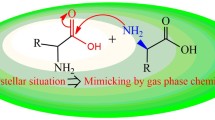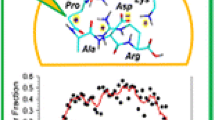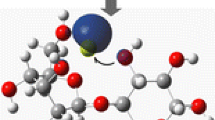Abstract
Under the conditions of low-energy collision-induced dissociation (CID), the canonical glycylphosphoserinyltryptophan radical cation having its radical located on the side chain of the tryptophan residue ([G p SW]•+) fragments differently from its tautomer with the radical initially generated on the α-carbon atom of the glycine residue ([G• p SW]+). The dissociation of [G• p SW]+ is dominated by the neutral loss of H3PO4 (98 Da), with backbone cleavage forming the [b2 – H]•+/y1 + pair as the minor products. In contrast, for [G p SW]•+, competitive cleavages along the peptide backbone, such as the formation of [G p SW – CO2]•+ and the [c2 + 2H]+/[z1 – H]•+ pair, significantly suppress the loss of neutral H3PO4. In this study, we used density functional theory (DFT) to examine the mechanisms for the tautomerizations of [G• p SW]+ and [G p SW]•+ and their dissociation pathways. Our results suggest that the dissociation reactions of these two peptide radical cations are more efficient than their tautomerizations, as supported by Rice–Ramsperger–Kassel–Marcus (RRKM) modeling. We also propose that the loss of H3PO4 from both of these two radical cationic tautomers is preferentially charge-driven, similar to the analogous dissociations of even-electron protonated peptides. The distonic radical cationic character of [G• p SW]+ results in its charge being more mobile, thereby favoring charge-driven loss of H3PO4; in contrast, radical-driven pathways are more competitive during the CID of [G p SW]•+.

ᅟ






Similar content being viewed by others
References
Hunter, T.: Signaling—2000 and beyond. Cell 100, 113–127 (2000)
Palumbo, A.M., Tepe, J.J., Reid, G.E.: Mechanistic insights into the multistage gas-phase fragmentation behavior of phosphoserine- and phosphothreonine-containing peptides. J. Proteome Res. 7, 771–779 (2008)
Ruijtenbeek, R., Versluis, C., Heck, A.J.R., Redegeld, F.A.M., Nijkamp, F.P., Liskamp, R.M.J.: Characterization of a phosphorylated peptide and peptoid and peptoid–peptide hybrids by mass spectrometry. J. Mass Spectrom. 37, 47–55 (2002)
Kang, J., Toita, R., Jiang, Y., Niidome, T., Katayama, Y.: Simultaneous analysis of phosphorylated peptides by MALDI-TOF-MS. Chromatographia 63, 595–598 (2006)
Bailey, C.M., Sweet, S.M.M., Cunningham, D.L., Zeller, M., Heath, J.K., Cooper, H.J.: SLoMo: automated site localization of modifications from ETD/ECD mass spectra. J. Proteome Res. 8, 1965–1971 (2009)
Gehrig, P.M., Roschitzki, B., Rutishauser, D., Reiland, S., Schlapbach, R.: Phosphorylated serine and threonine residues promote site-specific fragmentation of singly charged, arginine-containing peptide ions. Rapid Commun. Mass Spectrom. 23, 1435–1445 (2009)
Mann, M., Ong, S.E., Gronforg, M., Steen, H., Jensen, O.N., Pandey, A.: Analysis of protein phosphorylation using mass spectrometry: deciphering the phosphoproteome. Trends Biotechnol. 20, 261–268 (2002)
Hoffert, J.D., Knepper, M.A.: Taking aim at shotgun phosphoproteomics. Anal. Biochem. 375, 1–10 (2008)
Laskin, J., Futrell, J.H.: Activation of large ions in FT-ICR mass spectrometry. Mass Spectrom. Rev. 24, 135–167 (2005)
Zubarev, R.A.: Reactions of polypeptide ions with electrons in the gas phase. Mass Spectrom. Rev. 22, 57–77 (2003)
Syka, J.E.P., Coon, J.J., Schroeder, M.J., Shabanowitz, J., Hunt, D.F.: Peptide and protein sequence analysis by electron transfer dissociation mass spectrometry. Proc. Natl. Acad. Sci. U. S. A. 101, 9528–9533 (2004)
Barlow, C.K., McFadyen, W.D., O’Hair, R.A.J.: Formation of cationic peptide radicals by gas-phase redox reactions with trivalent chromium, manganese, iron, and cobalt complexes. J. Am. Chem. Soc. 127, 6109–6115 (2005)
Hodyss, R., Cox, H.A., Beauchamp, J.L.: Bioconjugates for tunable peptide fragmentation: free radical initiated peptide sequencing (FRIPS). J. Am. Chem. Soc. 127, 12436–12437 (2005)
Hopkinson, A.C., Siu, K.W.M.: Peptide radical cations. In: Principles of Mass Spectrometry Applied to Biomolecules, pp. 301–335. John Wiley and Sons, New Jersey (2006)
Kemp, M., Roitberg, A., Mujica, V., Wanta, T., Ratner, M.A.: Molecular wires: extended coupling and disorder effects. J. Phys. Chem. 100, 8349–8355 (1996)
Laskin, J., Yang, Z., Lam, C., Chu, I.K.: Charge-remote fragmentation of odd-electron peptide ions. Anal. Chem. 79, 6607–6614 (2007)
Levis, R.J.: Laser desorption and ejection of biomolecules from the condensed phase into the gas phase. Annu. Rev. Phys. Chem. 45, 483–518 (1994)
Ly, T., Julian, R.R.: Residue-specific radical-directed dissociation of whole proteins in the gas phase. J. Am. Chem. Soc. 130, 351–358 (2007)
Ly, T., Julian, R.R.: Ultraviolet photodissociation: developments towards applications for mass-spectrometry-based proteomics. Angew. Chem. Int. Ed. 48, 7130–7137 (2009)
Matsumoto, Y., Watanabe, K.: Coherent vibrations of adsorbates induced by femtosecond laser excitation. Chem. Rev. 106, 4234–4260 (2006)
Schlag, E.W., Lin, S.H., Weinkauf, R., Rentzepis, P.M.: Dynamical principles in biological processes. Proc. Natl. Acad. Sci. U. S. A. 95, 1358–1362 (1998)
Hopkinson, A.C.: Radical cations of amino acids and peptides: structures and stabilities. Mass Spectrom. Rev. 28, 655–671 (2009)
Chu, I.K., Lam, C.N.W.: Generation of peptide radical dications via low-energy collision-induced dissociation of [CuII(terpy)(M + H)]•3+. J. Am. Soc. Mass Spectrom. 16, 1795–1804 (2005)
Chu, I.K., Lam, C.N.W., Siu, S.O.: Facile generation of tripeptide radical cations in vacuo via intramolecular electron transfer in CuII tripeptide complexes containing sterically encumbered terpyridine ligands. J. Am. Soc. Mass Spectrom. 16, 763–771 (2005)
Chu, I.K., Siu, S.O., Lam, C.N.W., Chan, J.C.Y., Rodriquez, C.F.: Formation of molecular radical cations of aliphatic tripeptides from their complexes with CuII(12-crown-4). Rapid Commun. Mass Spectrom. 18, 1798–1802 (2004)
Lam, C.N.W., Chu, I.K.: Formation of anionic peptide radicals in vacuo. J. Am. Soc. Mass Spectrom. 17, 1249–1257 (2006)
Lam, C.N.W., Ruan, E.D.L., Ma, C.Y., Chu, I.K.: Non-zwitterionic structures of aliphatic-only peptides mediated the formation and dissociation of gas phase radical cations. J. Mass Spectrom. 41, 931–938 (2006)
Kong, R.P.W., Quan, Q., Hao, Q., Lai, C.K., Siu, C.K., Chu, I.K.: Formation and dissociation of phosphorylated peptide radical cations. J. Am. Soc. Mass Spectrom. 23, 2094–2101 (2012)
Palumbo, A.M., Reid, G.E.: Evaluation of gas-phase rearrangement and competing fragmentation reactions on protein phosphorylation site assignment using collision induced dissociation-MS/MS and MS3. Anal. Chem. 80, 9735–9747 (2008)
Henke, W., Kremer, S., Reinen, D.: Cu2+ in five-coordination: a case of a second-order Jahn–Teller effect. 1. Structure and spectroscopy of the compounds Cu(terpy)X2•nH2O. Inorg. Chem. 22, 2858–2863 (1983)
Chan, W.C., White, P.D.: Fmoc Solid Phase Peptide Synthesis: A Practical Approach. Oxford University Press, New York (2000)
SPARTAN, '04 Essential V2.0.0. Wavefunction, Inc., Irvine (2004)
Frisch, M.J., Trucks, G.W., Schlegel, H.B., Scuseria, G.E., Robb, M.A., Cheeseman, J.R., Montgomery Jr., J.A., Vreven, T., Kudin, K.N., Burant, J.C., Millam, J.M., Iyengar, S.S., Tomasi, J., Barone, V., Mennucci, B., Cossi, M., Scalmani, G., Rega, N., Petersson, G.A., Nakatsuji, H., Hada, M., Ehara, M., Toyota, K., Fukuda, R., Hasegawa, J., Ishida, M., Nakajima, T., Honda, Y., Kitao, O., Nakai, H., Klene, M., Li, X., Knox, J.E., Hratchian, H.P., Cross, J.B., Bakken, V., Adamo, C., Jaramillo, J., Gomperts, R., Stratmann, R.E., Yazyev, O., Austin, A.J., Cammi, R., Pomelli, C., Ochterski, J.W., Ayala, P.Y., Morokuma, K., Voth, G.A., Salvador, P., Dannenberg, J.J., Zakrzewski, V.G., Dapprich, S., Daniels, A.D., Strain, M.C., Farkas, O., Malick, D.K., Rabuck, A.D., Raghavachari, K., Foresman, J.B., Ortiz, J.V., Cui, Q., Baboul, A.G., Clifford, S., Cioslowski, J., Stefanov, B.B., Liu, G., Liashenko, A., Piskorz, P., Komaromi, I., Martin, R.L., Fox, D.J., Keith, T., Al-Laham, M.A., Peng, C.Y., Nanayakkara, A., Challacombe, M., Gill, P.M.W., Johnson, B., Chen, W., Wong, M.W., Gonzalez, C., Pople, J.A.: Gaussian 03, Revision C.02. Gaussian, Inc, Wallingford (2004)
Baer, T., Hase, W.L.: Unimolecular Reaction Dynamics: Theory and Experiments. Oxford University Press, New York (1996)
Baer, T., Mayer, P.M.: Statistical Rice–Ramsperger–Kassel–Marcus quasiequilibrium theory calculations in mass spectrometry. J. Am. Soc. Mass Spectrom. 8, 103–115 (1997)
Ng, D.C.M., Song, T., Siu, S.O., Siu, C.K., Laskin, J., Chu, I.K.: Formation, isomerization, and dissociation of α-carbon-centered and π-centered glycylglycyltryptophan radical cations. J. Phys. Chem. B 114, 2270–2280 (2010)
Siu, C.K., Ke, Y., Orlova, G., Hopkinson, A.C., Siu, K.W.M.: Dissociation of the N–Cα bond and competitive formation of the [zn – H]•+ and [cn + 2H]+ product ions in radical peptide ions containing tyrosine and tryptophan: the influence of proton affinities on product formation. J. Am. Soc. Mass Spectrom. 19, 1799–1807 (2008)
Song, T., Hao, Q., Law, C.H., Siu, C.K., Chu, I.K.: Novel Cβ–Cγ bond cleavages of tryptophan-containing peptide radical cations. J. Am. Soc. Mass Spectrom. 23, 264–273 (2012)
Song, T., Ma, C.Y., Chu, I.K., Siu, C.K., Laskin, J.: Mechanistic examination of Cβ–Cγ bond cleavages of tryptophan residues during dissociations of molecular peptide radical cations. J. Phys. Chem. A 117, 1059–1068 (2013)
Lioe, H., O’Hair, R.A.J.: Neighbouring group processes in the deamination of protonated phenylalanine derivatives. Org. Biomol. Chem. 3, 3618–3628 (2005)
Acknowledgments
The authors thank the Hong Kong Research Grants Council (RGC), Hong Kong Special Administrative Region (HKSAR), China, for financial support (HKU7016/10P and HKU7016/11P). Q.Q. thanks the Hong Kong RGC for supporting her studentship. C.K.S. is grateful to City University of Hong Kong for financial support (project no. 7002733). I.K.C. acknowledges support from the US Department of Energy, Office of Basic Energy Sciences, Division of Chemical Sciences, Geosciences, and Biosciences. Pacific Northwest National Laboratory (PNNL) is a multiprogram national laboratory operated for the DOE by Battelle.
Author information
Authors and Affiliations
Corresponding authors
Electronic Supplementary Material
Below is the link to the electronic supplementary material.
ESM 1
(DOCX 473 kb)
Rights and permissions
About this article
Cite this article
Quan, Q., Hao, Q., Song, T. et al. Mechanistic Investigation of Phosphate Ester Bond Cleavages of Glycylphosphoserinyltryptophan Radical Cations under Low-Energy Collision-Induced Dissociation. J. Am. Soc. Mass Spectrom. 24, 554–562 (2013). https://doi.org/10.1007/s13361-013-0597-x
Received:
Revised:
Accepted:
Published:
Issue Date:
DOI: https://doi.org/10.1007/s13361-013-0597-x




